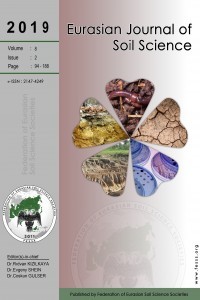
Eurasian Journal of Soil Science
Yazarlar: David PİNSKİY, Anastasiya MALTSEVA, Berta ZOLOTAREVA
Konular:-
DOI:10.18393/ejss.86540
Anahtar Kelimeler:Humification,Humic substances,Mineral substrate,Densitometric fractionation
Özet: The influence of the composition and properties of the mineral matrix in soils on the humification of corn residues was studied. The substrate (silica sand, loam, silica sand + 10% bentonite, or silica sand + 30% kaolinite) was mixed with 10% corn residues (milled to 3–5 mm) and incubated under stationary conditions for 6–19 months. Sampling for the analysis was performed every month, and a few times in the first month. The dynamics of mineralization and humification of plant residues was studied by applying elemental and bulk analyses of neogenic organic matter (OM), densitometric fractionation of substrates, FTIR spectroscopy, solid-phase 13C-NMR spectroscopy, and scanning electron microscopy with an electron microprobe. It was shown that the humification processes had a wavelike character for loam and sand substrates, which could be explained by the transformation of the microorganism populations together with the change in the amount and quality of OM in the system. The main mechanism for the stabilization of neogenic OM was adsorption on a mineral matrix with formation of relatively resistant compounds. This adsorption can be selective, depending on the composition and properties of the mineral matrix. The FTIR and 13C-NMR analyses of OM distribution in different substrates and densitometric fractions showed that sand and heavy fractions (HF >2.2 g/cm3) were enriched with compounds of an aromatic nature and polypeptides. Light fractions (LF-2, 1.4–2.2 g/cm3) accumulated compounds that also contained alkyl and carboxyl groups. The sandy substrate and HF have higher aromaticity indices than LF-2. Higher aromaticity index values of humus substances in the sandy substrate and HF in the loamy substrate, compared to LF-2, evidenced the formation of steady aromatic compounds, in which there may be kernels of humic acids (HA). We do not exclude the possibility of the matrix synthesis of the HA-like substances.